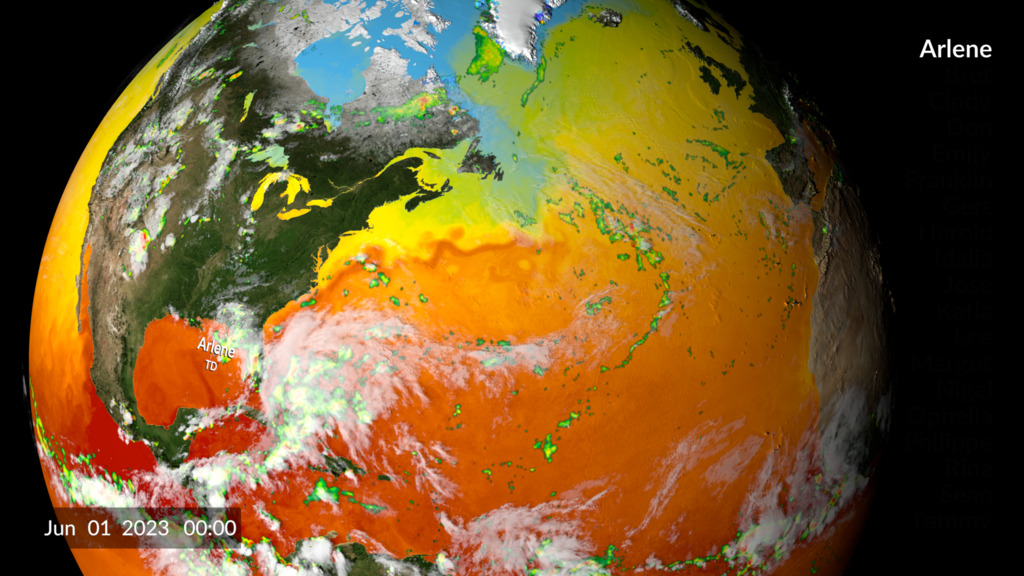Calvin becomes first major hurricane in the East Pacific
Hurricane Calvin on July 15, 2023 at approximately 8:45 UTC. as it continues to move toward the Hawaiian Islands.
After a quiet start, the 2023 eastern Pacific hurricane season has picked up in activity recently with the formation of the season’s first major hurricane, Hurricane Calvin. Calvin originated back on July 11th from an area of low pressure located about 510 miles (~820 km) south-southwest of Manzanillo, Mexico, which had become organized enough for the National Hurricane Center (NHC) to declare it Tropical Depression 3E (TD 3E) that afternoon. Located over warm sea surface temperatures (SSTs) of around 29 oC (~84 oF), thunderstorm activity near the center of TD 3E continued to increase overnight, and during the early morning hours of the 12th, NHC upgraded the depression to Tropical Storm Calvin. Calvin continued to track westward over the open waters of the eastern Pacific well away from land. Warm SSTs and light-to-moderate wind shear formed an environment conducive for intensification, and Calvin continued to strengthen throughout the 12th, becoming a hurricane at 5:00 am (HST, Hawaii Standard Time) on the morning of the 13th. Calvin continued to strengthen throughout the day and following night, becoming a Category 2 by 5:00 pm (HST) on the 13th and a Category 3 storm by 5:00 am (HST) on the 14th with maximum sustained winds estimated at 120 mph.
The combination of NASA’s IMERG precipitation product and the GPM Core Observatory satellite with its array of active and passive sensors is ideal for monitoring and studying tropical cyclones, especially over the open ocean where land-based radar data is scarce. The following NASA animation shows Calvin as it tracks through the eastern Pacific roughly halfway between the west coast of Mexico and Hawaii. The first part of the animation shows a time loop of IMERG surface rainfall estimates beginning at 8:20 UTC July 14th (10:20 pm HST July 13th) overlaid on IR cloud top data. The animation begins when Calvin is already a Category 2 hurricane. IMERG shows that Calvin had a well-developed though still somewhat asymmetric precipitation field with heavy rain wrapped completely around a barely discernable eye along with an large area of heavy rain wrapping around the eastern side of the storm. IMERG shows that over the next 24 hours, Calvin’s eye tended to become more pronounced and the rain field more symmetric as the storm continued to intensify.
During the night of the 14th/15th, the GPM Core Observatory flew over the center of Calvin. The second part of the animation shows a detailed look into the structure and intensity of the precipitation within Calvin from the GPM Core Observatory around 9:53 UTC July 15th (11:53 pm HST July 14th). Surface rainfall estimates from the GPM Microwave Imager (GMI) and Dual-frequency Precipitation Radar (DPR) show Calvin is fairly symmetric with heavy rainbands (shown in red) wrapping nearly completely around a fairly well-defined eye at the center. An area of extremely heavy rain (shown in purple) is located in the western part of the eyewall. The DPR actively scanned Calvin to provide a 3D perspective of its precipitation. Areas shaded in blue show frozen precipitation aloft, mainly in the form of snow but also graupel (rimed snow particles) and frozen drops, which are both present in the cores of active thunderstorms. The DPR shows that the tallest, deepest thunderstorms with precipitation tops exceeding 10 km are located in the western part of the eyewall in association with the heaviest rain also west of the center. At the time of the GPM overpass, Calvin had already reached its peak intensity and was starting to weaken a result of passing over cooler SSTs. Maximum sustained winds were reported at 105 mph by NHC.
Calvin continued to weaken over the next couple of days, and as of 8:00 am HST July 17th, Calvin, now a moderate intensity tropical storm, was located about 850 miles east of Hilo, Hawaii and is expected to pass just south of the Big Island of Hawaii as a weak tropical storm..

Color bar for frozen precipitation rates (ie, snow rates). Shades of cyan represent low amounts of frozen precipitation, whereas shades of purple represent high amounts of precipitation.

Color bar for liquid precipitation rates (ie, rain rates). Shades of green represent low amounts of liquid precipitation, whereas shades of red represent high amounts of precipitation.
Credits
Please give credit for this item to:
NASA's Scientific Visualization Studio. Data provided by the joint NASA/JAXA GPM mission.
-
Data visualizers
- Alex Kekesi (Global Science and Technology, Inc.)
- Greg Shirah (NASA/GSFC)
-
Scientists
- George Huffman (NASA/GSFC)
- Scott Braun (NASA/GSFC)
- Jacob Reed (Telophase)
-
Writer
- Stephen Lang (SSAI)
-
Technical support
- Laurence Schuler (ADNET Systems, Inc.)
- Ian Jones (ADNET Systems, Inc.)
Release date
This page was originally published on Monday, July 17, 2023.
This page was last updated on Monday, January 6, 2025 at 12:44 AM EST.
Missions
This page is related to the following missions:Series
This page can be found in the following series:Datasets used
-
CPC (Climate Prediction Center) Cloud Composite
ID: 600Global cloud cover from multiple satellites
See all pages that use this dataset -
Rain Rates (Surface Precipitation) [GPM: GMI]
ID: 822Credit: Data provided by the joint NASA/JAXA GPM mission.
See all pages that use this dataset -
Volumetric Precipitation data (Ku) [GPM: DPR]
ID: 830Credit: Data provided by the joint NASA/JAXA GPM mission.
See all pages that use this dataset -
IMERG
ID: 863This dataset can be found at: http://pmm.nasa.gov/sites/default/files/document_files/IMERG_ATBD_V4.4.pdf
See all pages that use this dataset
Note: While we identify the data sets used on this page, we do not store any further details, nor the data sets themselves on our site.
